Japan
Wood Products Prices
Dollar Exchange Rates of 10th
Nov
2021
Japan Yen 113.88
Reports From Japan
Open for business travel
Japan has partially eased travel restrictions for foreign
nationals entering the country. New arrivals will be
allowed in for the first time in 10 months but visits for
tourism will not be allowed.
The measure applies to short-term stays of up to three
months for business and working purposes as well as longterm
stays by foreign students, foreign technical trainees
and others. Companies and organisations such as schools
that sponsor foreigners to Japan need to pass screenings by
the relevant ministry or agency in advance. However a 14
day quarantine is still required.
Exports pulled down
A key gauge of business conditions in Japan, the
Coincident Index, fell in September, marking the third
decline in a row as car production and exports slumped.
Cabinet officials said the pandemic made it difficult to
obtain car parts from Southeast Asian suppliers and this
led to a drop in production and exports. Both retail and
wholesale sales remain flat despite the lifting of most
restriction in October as the country has seen a sharp drop
in new virus cases.
Looking ahead the Cabinet Office downgraded its
assessment of the index to "weakening" from "improving".
The leading index of business conditions, forecasting the
situation in the coming months, fell 1.6 points to 99.7 in
September, down for the third consecutive month.

New stimulus package to be announced
The government is set to approve economic stimulus
measures that will exceed US$350 billion, a sharp rise
from its initial plan due to the inclusion of cash handouts.
Under the COVID-19 relief measures there will be Yen
100,000 handouts in cash and vouchers for children aged
18 or younger as well as aid for students facing financial
difficulties.
The package will also include financial aid of up to yen
2.5 million for businesses suffering from plunging
revenues due to the virus spread. Restarting the
government's "Go To Travel" programme, intended to
subsidise travel spending to help the coronavirus-hit
domestic tourism industry will also be among the stimulus
measures. The earlier go-to scheme was suspended amid
the rapid spread of infections.
Retail sales trend higher as infection rate drops
Consumers responded to the sharp decline in the rate of
infections and spending rose with retail sales regaining
some lost ground in September. The Ministry of Economy,
Trade and Industry reported sales gained 1.2% in the
September quarter compared with three months earlier, the
fastest increase in a year.
The strong gain suggests overall consumption, the biggest
component of the economy, may not have declined in the
September quarter as much as feared.
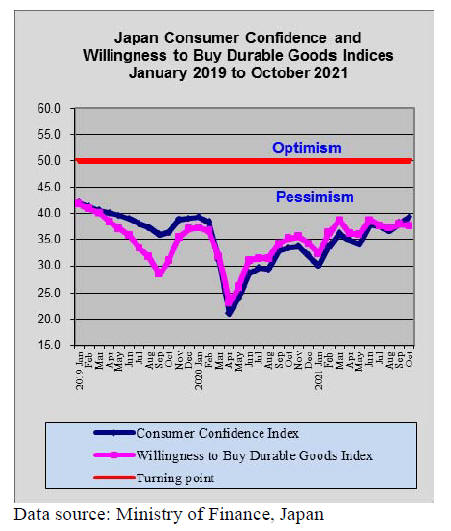
Homes getting even smaller
Declining population and smaller family units have led,
over recent years, to a continuing contraction of the
housing market and consequently the demand for
sawnwood and engineered wood products for residential
housing. The average size of a new customised house fell
from 141 sq.m in 1996 to 119 sq.m in 2019.
The current trend in work from home may reverse this
trend to smaller homes as those looking to build a home
consider a location where land is cheaper and consider a
large home to accommodate the home office. However,
this change in work style is unlikely to significantly affect
average home sizes in the country or demand for wood
construction products. As the wood demand in the
Japanese residential construction sector continues to
decline and wood products from domestic resources are
increasing the overall outlook for higher sawnwood and
plywood imports by Japan is not bright.
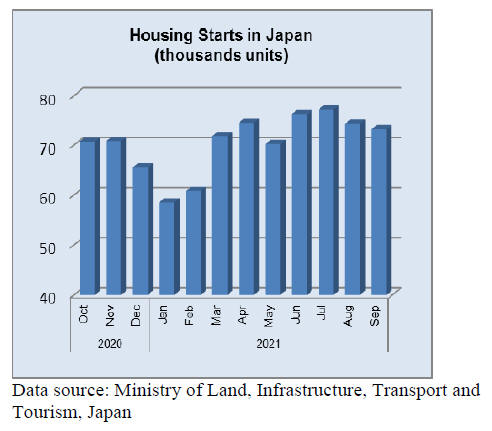
Higher costs being passed on to consumers
The prolonged weakness of the yen against the US dollar
has driven up import costs. Until recently companies have
been absorbing the higher costs but sharply higher oil
prices have increased transportation cost so some
companies are beginning to pass on the rises to consumers.
The Yen has been trading at around 113-114 to the dollar
for about a month, a four-year low and weaker than the
103 level at the start of 2021.
See:
https://www.reuters.com/article/japan-companies/pollaround-half-of-japan-firms-looking-to-pass-on-risingcommodity-costs-to-customers-idUSL4N2RY0YL

Import update
Wooden door Imports (HS441820)
Year on year, September wooden door imports
(HS441820) were 9% higher than in 2020 but still well
below(-19%) the value of September 2019 imports.
September marked the third consecutive decline in the
value of wooden door imports. Compared to August, the
value of September imports was down 10% following the
almost 9% month on month drop in August.
China accounted for 53% of Japan¡¯s September 2021
imports of wooden doors (c.f. 61% in Aug.) with a further
being shipped to Japan from the Philippines (c.f. 25% in
Aug.). Two other shippers, Indonesia and Sweden,
increased shipments in September (6.5% from Indonesia
and 2.5% from Sweden).
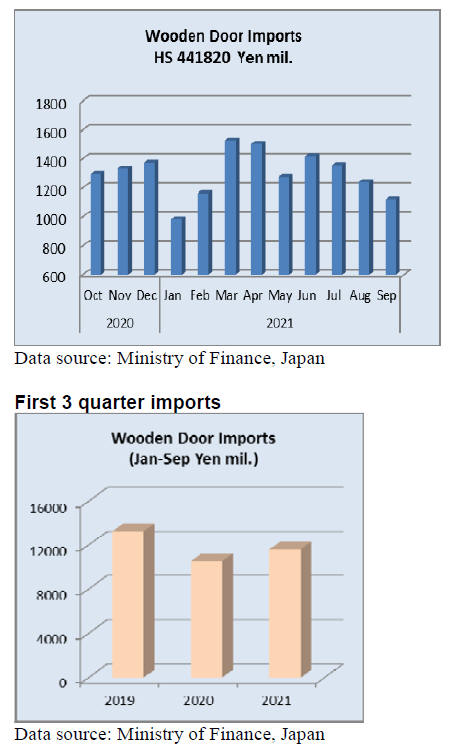 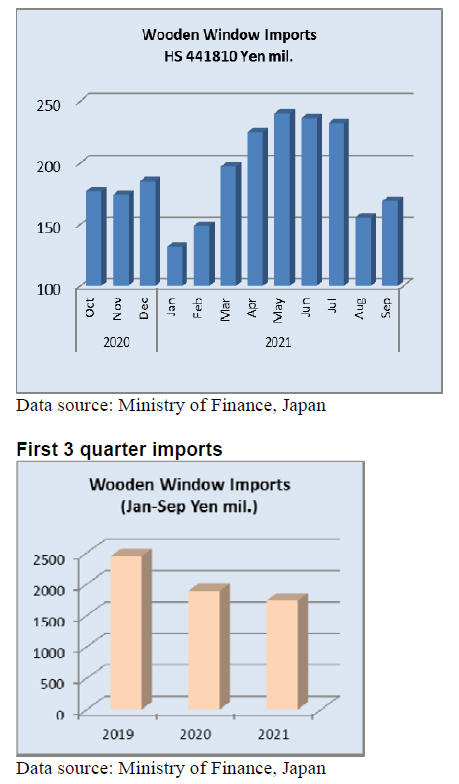
Assembled wooden flooring imports
The value of assembled flooring (HS441471-79) imports
has been see-sawing since mid-year and imports in
September dropped back to around the same level as in
July. Year on year, the value of Japan¡¯s imports of
assembled wooden flooring in September rose 22% (c.f.
62% in Aug) and they were well up (32%) on the value of
September 2019 imports. Compare to the value of August
imports there was a 16% decline in September.
As in pevious months imports of HS441875 was the main
category (76% Sept. c.f. 85% in Aug.) with most coming
from China, Vietnam, Thailand and Malaysia. Of
shipments of the second ranked category (HS441879)
Indonesia and Malaysia were the main shippers in
September with smaller amount coming from China,
Vietnam and Thailand.
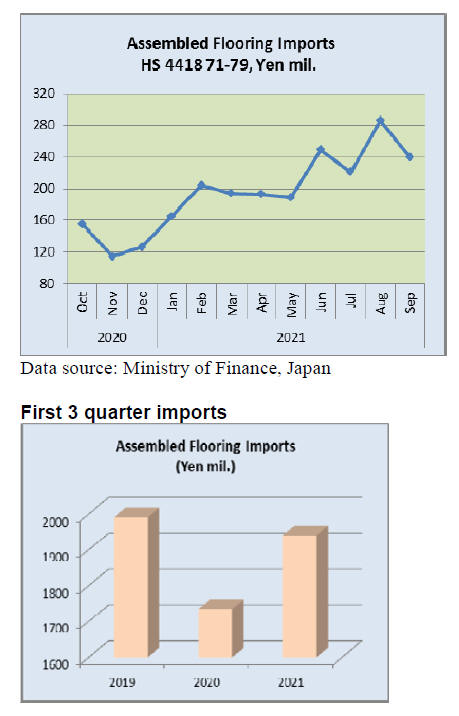
Plywood imports
Japan¡¯s plywood imports rose 12% in September
compared to a month earlier and at 161,000 cu.m were
higher than in both 2020 (65% up) and 2019 (17% up). In
September all four shippers of plywood, Malaysia,
Indonesia, China and Vietnam posted gains over the
volume of August shipments.

From the beginning of this year shipments of plywood
from Vietnam have outpaced those from China but it is not
known if this reflects an expansion of production in
Vietnam or the addition of Chinese product exported to
Japan via Vietnam.
Of all shipments in September HS441231 accounted for
over 85% while HS441234 acounted for 7%.
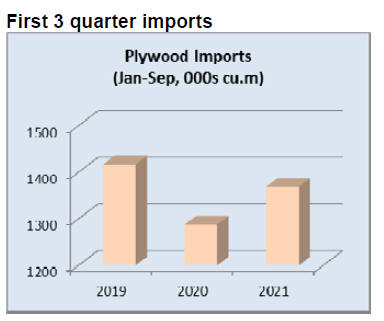 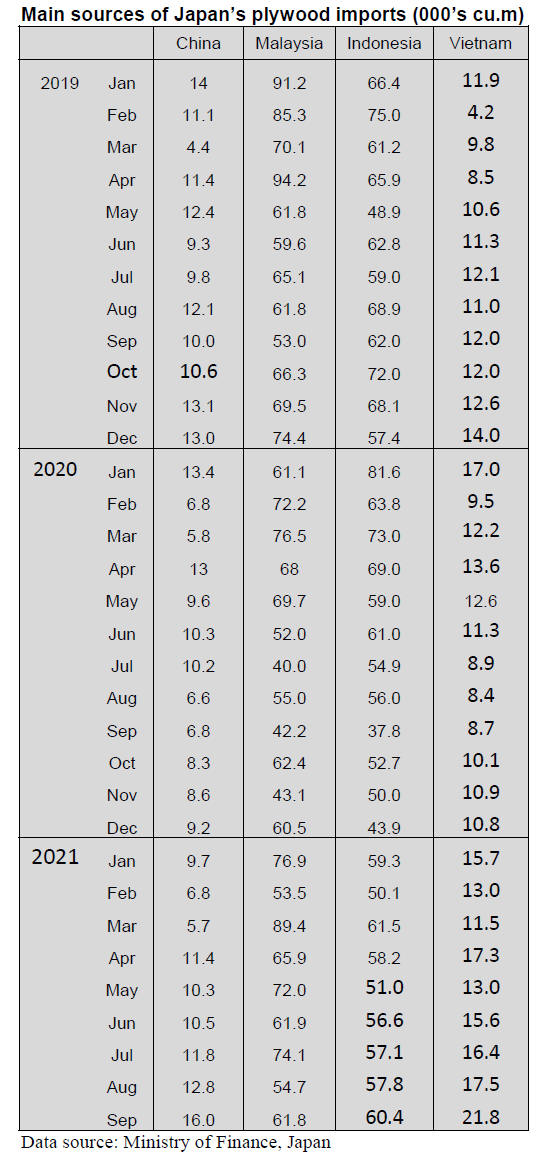
Trade news from the Japan Lumber Reports (JLR)
The Japan Lumber Reports (JLR), a subscription trade
journal published every two weeks in English, is
generously allowing the ITTO Tropical Timber Market
Report to reproduce news on the Japanese market
precisely as it appears in the JLR.
For the JLR report please see:
https://jfpj.jp/japan_lumber_reports/
Price increase of softwood plywood
Domestic softwood plywood manufacturers decided to
increase the sales prices of 12 mm 3x6 panel to 1,300 yen
per sheet delivered since November 1. Together with 12
mm, 24mm thick panel prices will be 2,600 yen and 28
mm thick panel will be 3,000-3,050 yen per sheet
delivered.
Reasons of price hike are difficulty of acquiring enough
logs. Competition among plywood mills, sawmills and
laminated lumber mills is fierce everywhere regardless of
species. Not only cedar but cypress and larch are hard to
buy and there is no outlook that the situation would ease.
Plywood mills say that they can buy only 70-80% of
desired volume.
Besides domestic raw materials, imported materials are
also hard to have enough. Russian made larch veneer is
not enough because of delayed shipping with shortage of
shipping space so plywood mills¡¯ inventory is minimum.
North American Douglas fir logs are also hard to have
enough by supply shortage. Raw materials management is
becoming very difficult.
On top of raw materials¡¯ supply, adhesive prices are
climbing as crude oil prices exceed $80 per barrel and all
the petro-chemical products prices seem to keep
climbing.Also because of power shortage in China, supply
of chemical products like urea is getting tight so raw
materials of adhesive are getting tight and the prices are
inflating. Adhesive manufacturers say that they are asking
plywood mills higher prices month after month since
volume of adhesive plywood mills use is large.
While the manufacturers struggle to secure enough raw
materials, the demand of softwood plywood is brisk and
precutting plants are facing tough management of plywood
as delayed delivery is becoming usual now.
Looking at retail prices at DIY stores, they are 1,400-
1,500 yen per sheet of 12 mm 3x6 panel. Actually there
are prices of 1,600 yen including 10% consumption tax. In
the past, DIY stores compete with each other and boast the
lowest prices in the area and up until September, the
lowest was 1,000 yen and the highest was 1,300 yen but
allocation volume by plywood mills has been declining
month after month.
Softwood plywood has been managed moderately by the
manufacturers, dealers and retailers and the dealers try to
keep the manufacturers¡¯ proposed prices to which the
manufacturers promise stable supply so there is no
fluctuation like imported plywood market. After the
supply got tight, precutting plants have started buying
from DIY stores so DIY stores limit the volume per sale.
Tokyo harbor¡¯s imported lumber inventory
Imported lumber inventory in Tokyo harbor at the end of
September is 131,000 cbms, 8.3% more than August. This
is the highest since September last year. Compared to the
bottom month of last January, it is 84.5% more. Reasons
are that the dealers try to retain the inventory so that the
incoming volume is larger than outgoing volume. Since
overseas export prices peaked out, inventory reduction
should gradually progress.
According to the Tokyo Lumber Terminal, inventory by
source, 43,000 cbms of North America, 34,000 cbms of
Europe, 19,000 cbms of Russia and 31 ,000 cbms of others
like China. Wooden board is 4,000 cbms. Lumber from
North America increased by 104.8% from end of January
and this is 48.3% more than a year ago and this is the
highest since October 2019.
European lumber increased by 126.7% from last January
but 19.0% less than the same month a year ago. Russian
lumber is 26.7% more than last January and 56.8% less
than September last year.
Others increased by 93.8% from January and 72.2% more
than September last year. Increased items are Chinese
poplar LVL and laminated lumber.
Incoming volume in September is 74.000 cbms, 1.3% less
than August, which is the second highest next to August.
The outgoing volume is 64,000 cbms, the highest month
this year but the inventory increased by 10,000 cbms.
Incoming volume bottomed in last November with 43,000
cbms then it has been steadily increasing.
Shipping companies avoid going to local ports and
concentrated calling Tokyo harbor for quick rotation of
containers. Delayed containers have started arriving one
after another, which increased the incoming volume.
Outgoing volume is likely to stay lower than incoming
until the importers and dealers complete passing higher
import cost to the buyers.
Tokyo Lumber Terminal forecasts inventory at the end of
October would be 132,000 cbms and 133,000 cbms at the
end of November.
Plywood ¨C supplies are very tight
Supply tightness gets serious month after month on both
domestic and imported plywood. Particularly domestic
softwood plywood supply is extremely tight and precutting
plants operate depending on supply of plywood. Shortage
of plywood is becoming shackles of precutting operations
and limit of number of orders they take.
Dealers¡¯ inventory is almost none as plywood flies out as
soon as it arrives. Particularly thick panel like 24 mm is
extremely short.
There are substituting demand of South Sea imported
hardwood plywood since the supply of imported structural
and standard plywood are short in supply.
There is no sign that the supply of hardwood plywood
increases. Malaysia and Indonesia are in rainy season so
log production seems to stay low until March next year.
Local plywood suppliers reduce supply volume with the
prices increasingUS $20 every month and the suppliers do
not mind having less orders.
Domestic logs and lumber
Movement of logs and lumber is slowing down except for
Hokkaido and the North East region.Particularly prices of
stud, brace, taruki and 120 mm square are weakening in
Kanto and Kyushu little by little with inactive demand. In
Kansai and Chugoku regions, the prices are unchanged.
Reason of this is shortage of plywood causes delaying of
construction works and increasing imported lumber causes
slower demand of cedar stud and taruki. Also increased
supply of cedar LVL and Chinese poplar LVL is easing
the market. 3 meter 105 mm KD cedar post prices are
unchanged at about 100,000 yen all over Japan.
In Kanto market, the prices climbed to 130,000 yen in last
summer but now it is hard to hold 120,000 yen. 3 meter
120 mm square prices soared to 120,000 yen but in
October, it dropped down to 95,0000 yen.
Only firm item is 4 meter KD 105 mm cypress sill square.
The prices are holding at 140,000-150,000 yen. Sawmills
continue full operation so log demand continues active and
in some areas, plywood mills, lumber mills and laminated
lumber mills compete with each other to acquire logs.
October weather is favorable so that log production is
increasing all over Japan but there is no surplus supply.
Log prices vary by the regions.
In Western Japan, cypress log prices had been 40,000-
50,000 yen since last June but now it is down to 35,000-
37,000 yen. In Northern Kanto, the prices had been about
25,000 yen then in October, they soared to 30,000 yen so
gap is narrowing between West and East. 3 meter post
cutting cedar log prices in Northern Kanto climbed to
about 18,000 yen and in other areas, they are 14,000 yen.
Marutama Plywood develops hardwood plywood
Marutama Plywood (Hokkaido), producer of Hokkaido
softwood log plywood, has been manufacturing about
360,000 cbms of local softwood plywood a year. Species
are 50% larch, 40% fir and 10% of others like spruce. It
plans to develop manufacturing plywood with local
hardwood logs like white birch.
The idea is to expand source of logs and hardwood species
are unused for plywood. It plans to use about 6,000 cbms
of hardwood logs a year. Manufactured products are for
floor and base panel of decorative plywood.
Since many hardwood logs have sweep so logs are cut to 1
meter to eliminate curved materials.
Species it plans to use is so-called junk hardwood species.
They are not valuable hardwood species like oak and ash
but abandoned species like white birch and alder. It has
already tested these species if they are usable as
commercial product and proved that they are good enough
materials as base materials. It tested other species like
cherry, elm, castor oil tree and bass wood. For floor base,
it is five layers of 2.55 mm veneer. Thin plywood is three
layers of 1.5 mm.
Marutama started ¡®White birch project¡¯ since several years
ago and discussed development of junk hardwood
plywood with Hokkaido prefectural government.
Utilization of unused junk hardwood species should
contribute vitalization of local forest industry.
However, unlike softwood species, sustainable supply
volume of junk hardwood species is small so it is hard to
secure large volume of logs so it plans to have about 6,000
cbms of logs a year by establishing log yard in several
places. President Ohkoshi is determined to lead success of
this project.
Congested Chinese port condition
Many wood imported products come to Japan by way of
Chinese ports. Delaying arrivals confuse market in Japan.
Ports around Shanghai suffer shortage of labor because of
COVID 19 epidemic then typhoons went through the area
during summer so loading and unloading of cargoes are
stagnating.
Another reason is that Chinese exporters increased
handling of containers, which caused congestion more. It
is reported that number of containers for North America is
50% more than early this year. There are many ships
waiting outside harbors and the congestion would last
through December at least. Demurrage is charged on
import cost of the products.
Wood products coming to Japan are from Europe, New
Zealand and Russia. Europe suffers shortage of containers
then congestion in Chinese ports for transshipping delays
arrivals so the third quarter lumber has started arriving
now and it would take through December to finish so the
fourth quarter cargoes are pushed over behind. Some took
three months before the cargo arrives.
Advantage of Russian products is short period delivery but
now transshipping schedule is confused and arrival time is
unstable. New Zealand log ship is scheduled to arrive at
Japan in October after the ship sailed in September but
arrival may be delayed by port condition in China.
|